You may have noticed brands like Lidl or Gymshark easily connect with users through their social channels, and consequently receive high volumes of audience engagement. But how have these brands got there? There is a lot to be said about building strong and recognizable identities that are communicated both online and offline. But brands who are able to do this well have the secret ingredient – an established tone of voice! In this article, we will be exploring tone of voice in marketing, and more importantly, how to effectively communicate it on social media!
What is Brand Tone of Voice?
Brand tone of voice (otherwise known as your verbal identity) is simply how you communicate and engage with your target audience using language. Your tone of voice characterises your brands’ personality – making your values stand out from others in the market.
Unsure where to begin? A good place to start is to imagine what your brand would sound like if they were a real person, and how they would be perceived. Your voice may be cheerful, casual, or conservative. Or perhaps flirty, friendly or downright funny! Your brand’s verbal identity reflects your visual identity (your logo, typography, colors and imagery) shaping how you communicate with your consumer.
The Importance of Tone of Voice
In this digital era where everything we do is social first, having a strong verbal identity is critical. Everything you ‘say’ can be shared amongst millions of people, on a global scale.
As it stands, it is hard enough getting your voice heard on social media, with it being such a noisy environment. That is why defining a tone of voice for your brand is key. Once it’s established, brands are able to do the following:
- Create genuine relationships and interactions with both current and future customers
- Allow users to familiarize themselves with a brand, which in time, builds trust and loyalty
- Develop a rapport with an audience, propelling them into conversation
- Communicate brand values and goals more effectively
How to Build Your Brand Tone of Voice
So, we now know what tone of voice is and why it is so important for our brand… but how do we find it?
Before defining your tone of voice, it is important to understand your overall strategy and recognize where your verbal identity will fit in. What is your vision, values and goals? It is important that your verbal identity is rooted in your brand’s DNA and is reflective of your industry and target audience.
Before making a decision, ask yourself:
- If your brand was a person, what would they be like?
- How would your brand be perceived by its peers if it were a real person?
- What relationship does your brand have with your customers? Would you be a parental figure? A friend? A teacher?
- What hobbies would your brand have if they were a real person?
- If your brand was a celebrity, who would they be?
- If your brand was an emoji, what emoji would it be?
Once you’ve established the foundations that define your verbal identity, you then want to write up some guidelines to ensure this identity hits all touchpoints of the brand in years to come. Mailchimp has a great ‘Tone of Voice Guidelines’ document to get you started.
Verbal Identity in a Social Era
Social media is called social for good reason. The core purpose of social media platforms is to communicate, socialize and build real relationships within different communities. This is why conveying a consistent message across your channels allows you to easily communicate campaigns to your audience.
The most successful social media strategies are those that engage and resonate with your target audience; prompting people to like, comment and share. The more engagement a post receives, the more chance the platform will show it to a wider audience.
Let’s be honest, in a real-life setting you are probably going to speak to your friends differently from your grandparents – the same rules apply to social media. Different channels are used to communicate different messages. For example, you are certainly going to take a more casual approach on TikTok than you would on a platform like LinkedIn. On Instagram, a ‘less is more’ attitude is more valuable in a visual space, whereas on Twitter you want to get your message out in less than 250 characters.
Need some inspiration? We’ve pulled together some social-first campaigns/activity that demonstrates a specific brand’s tone of voice that captured audiences and propelled conversations & engagement online.
- Let’s start with a Aldi’s feud over a caterpillar cake:
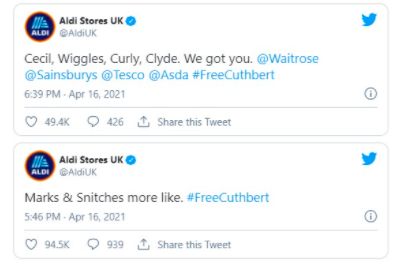
Aldi is notorious for a cheeky tone of voice on Twitter – the brand are quick with witty remarks at the expense of competitors. People love the brazen back and forth, resulting in tweets being shared on and off Twitter. Following Marks & Spencer’s announcement that they were taking legal action over the intellectual property rights of the Colin Caterpillar cake, Aldi launched a #FreeCuthbert hashtag on Twitter, to defend their own version of the cake named Cuthbert!
2. Burger King Billboards & Zoom
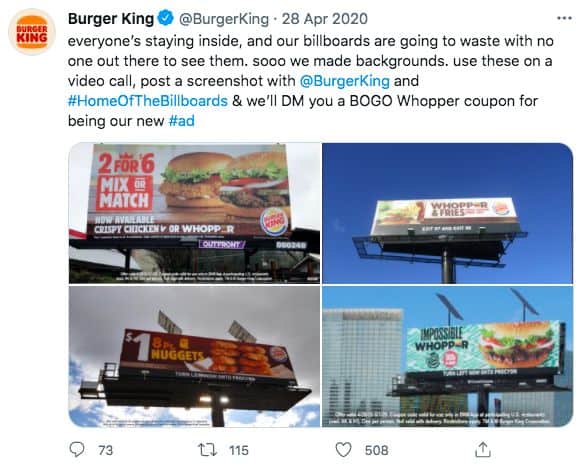
Burger King is known for reactive and cheeky marketing stunts and, during lockdown, the brand jumped on the opportunity to use video conferencing as a means of marketing. The brand incentivised its consumers in the US, through a Whopper voucher deal, to use Burger King billboards as Zoom backgrounds and then share on Twitter, tagging the brand and using the hashtag #BillboardOfTheWhopper.
3. Spotify Annual Wrapped Campaigns
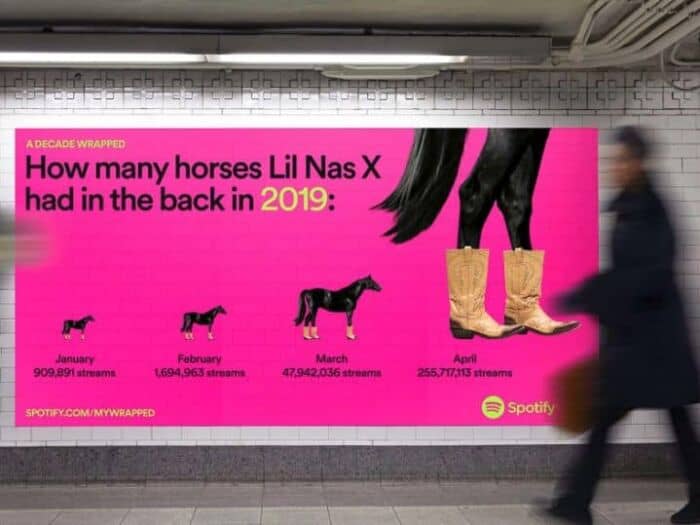
Spotify every year provides users with a personalized in-app wrap up, summing up their listening habits, whilst also launching a series of billboards and other marketing activities highlighting the year that just passed in a playful tone of voice that resonates with its user base. Spotify reported in 2019 that more than “60 million users engaged with the in-app story experience that racked up nearly 3 billion streams from Wrapped playlists” (Forbes, 2019). The campaign was also huge across social, with Spotify users sharing their listening habits across platforms. According to Twitter, in 2019 Wrapped was mentioned in at least 1.2 million posts during the campaign period.
4. Uber’s keeps the message simple post-lockdown
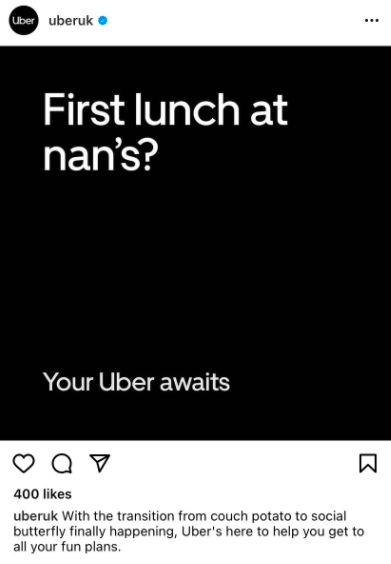
Uber returned in force in the UK with a marketing campaign coinciding with the easing of lockdowns. The communication was simple, personal and to-the-point, “Your Uber awaits” with various scenarios attached to the slogan that resonated with consumers of when they would jump on the app to order a ride. The campaign was seen across social and scattered across London in various OOO advertising spots, helping to place the ride-hailing app front-of-mind of consumers who were looking forward to seeing family and friends again.
5. Gymshark nailing viral tweets
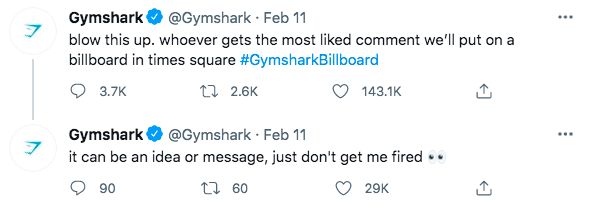
Now, Gymshark is a brand that knows its consumer inside out, and nothing demonstrates this better than the brand’s Twitter comms. The brand consistently post content that drives engagement and conversations across Twitter. Why? Well, every tweet is like your friend talking to you, if you didn’t see the brand name and logo, it might just look like a viral tweet being recommended to you by another user.
Translating Brand Tone of Voice Through Influencer Marketing
Now, Goat know a thing or two about influencer marketing, and brand tone of voice should be reflected in all influencer strategies. This is why finding the right influencers is imperative when building the foundations of a successful influencer marketing campaign. Aligning with the wrong influencers can confuse consumers or put them off your brand, so looking deeper at who that influencer is and how they talk to their audience is critical. While some influencers may have a following reflective of your target demographic, if their values and personality don’t align with your brand, then their followers may not purchase your product.
Paid Social & Tone of Voice
TOV is another factor that is important to consider, but often forgotten, when building out your paid social ads. If you don’t know what we mean by paid social (where have you been?!), it is a method of displaying adverts on popular social media channels, like Facebook or YouTube, that directly targets your key audience.
Paid social places your brand in front of an audience who may have never considered purchasing from you before, or perhaps even heard of you. With brand awareness campaigns especially, it is important to grab the users’ attention. Although visuals are a great way to get users to stop scrolling, tone of voice is important in gaining a great first impression. Again, consistency is key!
Conclusion
Your verbal identity is a critical piece of your branding, without it, there is no character, no personality that people can relate to. Just like in real life, your personality is what makes you stand out and unique to everyone else. It is no different when it comes to branding.
There is no one-size-fits-all approach when finding your brand’s verbal identity, and in fact, the more unique and recognizable your verbal identity is, the more engaging and memorable your brand will be for consumers!




